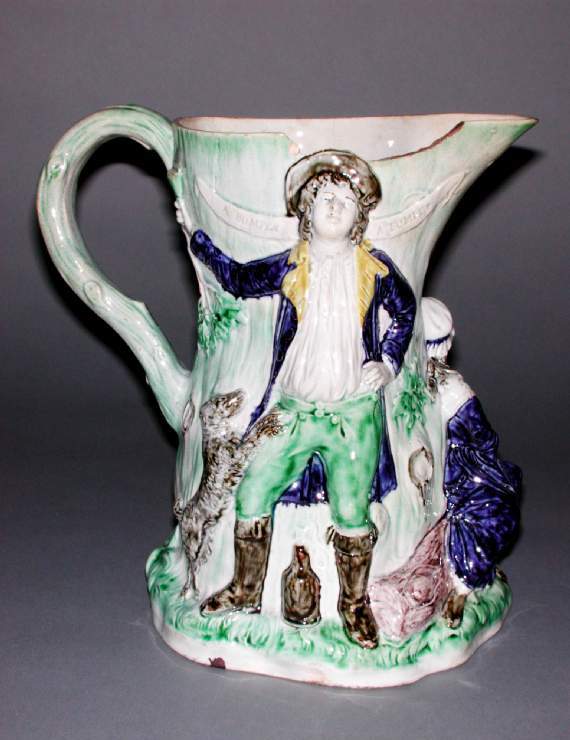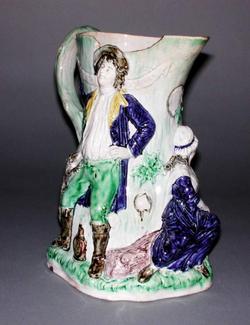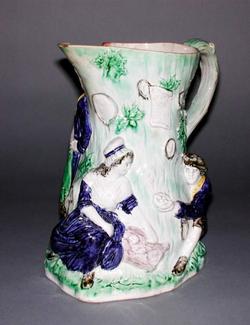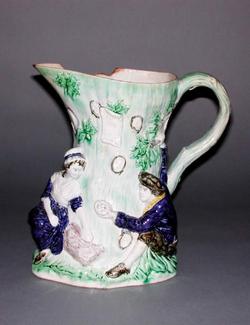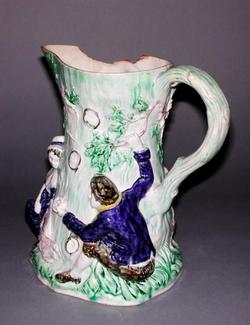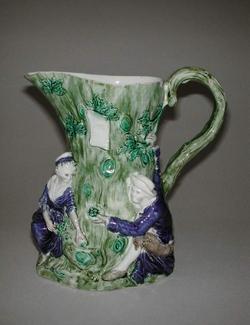Current Location: Gallery 27 (Glaisher)
Titles
Fair Hebe Jug
Maker(s)
Factory:
Richard Meir Astbury's Factory
Proprietor:
Astbury, Richard Meir
Modeller:
Voyez, John
Entities
Categories
Description
Cream earthenware, slip-cast and decorated with slightly blue-tinted clear, and blue, green, yellow, grey and black lead glazes
Notes
History note: John Bowden, Wardour Street, London, from whom purchased for £6 on 3 March 1899 by Dr J.W.L. Glaishe, FRS, Trinity College, Cambridge
Legal notes
Dr J.W.L. Glaisher Bequest
Measurements and weight
Height: 24.1 cm
Acquisition and important dates
Method of acquisition: Bequeathed
(1928-12-07)
by
Glaisher, J. W. L., Dr
Dating
18th Century, Late
George III
Circa
1788
CE
-
1790
CE
Note
Fair Hebe jugs were made in moulds taken from a model by John Voyez (1735-1800). Hebe was the subject of a song adapted from Part I of A Pastoral Ballad in Four Parts (1743), by William Shenstone (1714-1763). This origin is supported by a teapot modelled by Voyez, decorated with a portrait medallion of Shenstone on one side, and Fair Hebe and her lover on the other.
This jug bears the impressed initials RMA for the potter, Richard Meir Astbury of Fenton Others are known with the initials RG for Robert Garner, for example C.748-1928. An unusual, and probably unique caneware jug, with the impressed mark 'Sir/W.W.W./Bart' on its base was made at a short-lived pottery at Wynnstay, on Sir Williams Watkins Wynne's estate, which was set up with the aid of Voyez shortly before Wynne died in 1789. There are also much smaller examples, painted in enamels, such as C. 769-1928.
People, subjects and objects depicted
Components of the work
Decoration
Materials used in production
cream
Earthenware
slightly blue-tinted clear, and blue, green, yellow, grey and black
Lead-glaze
Techniques used in production
Slip-casting
: Cream earthenware, slip-cast and decorated with slightly blue-tinted clear, and blue, green, yellow, grey and black glazes
Lead-glaze
Inscription or legends present
- Text: FAIR HEBE
- Location: On outside on a paper on the oak tree
- Method of creation: Integrally moulded
- Type: Inscription
- Text: A BUMPER A BUMPER
- Location: On outside on label flanking the young man's head
- Method of creation: Integrally moulded
- Type: Inscription
Inscription present: impressed twice separately
- Text: ASTBURY
- Location: On base
- Method of creation: Impressed
- Type: Factory mark
Inscription present: very faintly
- Text: RMA
- Location: On outside of jug
- Method of creation: Moulded integrally with the jug
- Type: Initials
Inscription present: very faintly and not clear if I or J as first initial
- Text: J VOYEZ/1788
- Location: On outside of jug on log beside Hebe
- Method of creation: Moulded integrally with the jug
- Type: Inscription
References and bibliographic entries
Identification numbers
Accession number: C.747-1928
Primary reference Number: 75966
Old object number: 960
Stable URI
Audit data
Created: Saturday 6 August 2011
Updated: Tuesday 30 April 2024
Last processed: Tuesday 15 July 2025
Associated departments & institutions
Owner or interested party:
The Fitzwilliam Museum
Associated department:
Applied Arts
